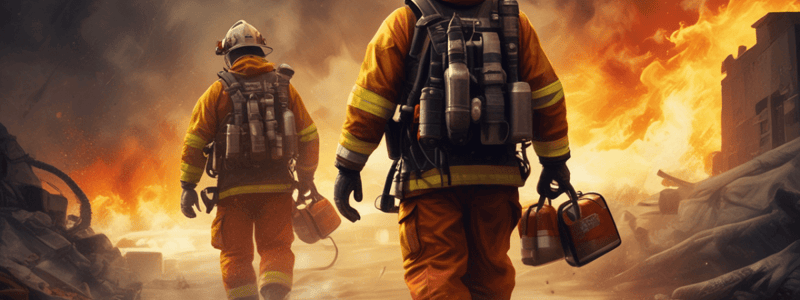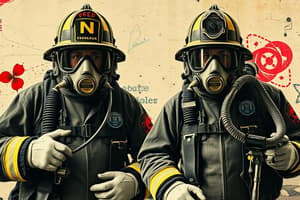Podcast
Questions and Answers
What is a primary concern with e-bikes and mobility devices in apartments?
What is a primary concern with e-bikes and mobility devices in apartments?
- They may interfere with fire alarm systems
- They may start fires
- They may cause electrical shocks
- They may obstruct escape routes in a fire situation (correct)
Why may TICs not give accurate readings for Lithium-ion batteries?
Why may TICs not give accurate readings for Lithium-ion batteries?
- Due to the remaining protection surrounding the battery (correct)
- Due to the battery's age
- Due to the battery's type
- Due to the battery's size
What is the primary extinguishing agent for fires involving Lithium-ion batteries?
What is the primary extinguishing agent for fires involving Lithium-ion batteries?
- Dry chemical
- Carbon dioxide
- Foam
- Water (correct)
What should be included in the 360-degree survey of a structure with photovoltaic solar panels?
What should be included in the 360-degree survey of a structure with photovoltaic solar panels?
Why should residents be questioned about the contents of their garage?
Why should residents be questioned about the contents of their garage?
What should be prepared for when extinguishing small fires involving Lithium-ion batteries?
What should be prepared for when extinguishing small fires involving Lithium-ion batteries?
Why may large fires involving Lithium-ion batteries be problematic to extinguish?
Why may large fires involving Lithium-ion batteries be problematic to extinguish?
What should be considered in a Defensive Operation for storage facilities or warehouses containing Lithium-ion batteries?
What should be considered in a Defensive Operation for storage facilities or warehouses containing Lithium-ion batteries?
Why should garage doors be avoided in electric vehicle fires?
Why should garage doors be avoided in electric vehicle fires?
What should Incident Commanders consider when developing their Incident Action Plan for electric vehicle fires?
What should Incident Commanders consider when developing their Incident Action Plan for electric vehicle fires?
What is the primary resource for information during a LIB event?
What is the primary resource for information during a LIB event?
Why should firefighters not hold the battery or cell in their hands?
Why should firefighters not hold the battery or cell in their hands?
What should be done with unaffected LIBs in the vicinity?
What should be done with unaffected LIBs in the vicinity?
Why should a thorough search for ejected cells be completed?
Why should a thorough search for ejected cells be completed?
What type of equipment should be used during LIB incidents?
What type of equipment should be used during LIB incidents?
What should be considered when dealing with LIBs that have been shut down or discharged?
What should be considered when dealing with LIBs that have been shut down or discharged?
What should firefighters do when encountering LIBs that are in thermal runaway or off-gassing?
What should firefighters do when encountering LIBs that are in thermal runaway or off-gassing?
Why may larger evacuation areas be required in high-rise buildings?
Why may larger evacuation areas be required in high-rise buildings?
Flashcards are hidden until you start studying
Study Notes
General Guidelines and Safety Considerations
- All TFS personnel working in a Controlled Area must wear full PPE, SCBA with face-piece worn for the duration of the event.
- No LIB assemblies or ESS containers will be opened or overhauled for safety.
- Upon confirmation of a LIB event, Heavy Haz and Haz Support will be requested if not already dispatched.
- Canutec (*666) is the primary resource for information and should be used as a reference to confirm all on-site information.
Ejected Cells and LIB Removal
- A thorough search for ejected cells must be completed and announced as a benchmark to the Incident Commander.
- Any unaffected LIBs in the vicinity should be removed using non-conductive tools to prevent their involvement.
- No TFS member will hold the battery or cell in their hands.
Hazardous Materials and LIBs
- LIBs are to be considered energized even after they have been shut down or discharged.
- Damaged, discharged LIBs may still contain a charge referred to as stranded energy.
- Non-conductive equipment should be used at these incidents where deemed a necessary safety precaution.
Evacuation and Safety Precautions
- Larger evacuation areas in high-rise buildings may be required due to the production of higher levels of toxic and flammable gases.
- Firefighters must stay out of the vapour cloud.
- E-bikes and mobility devices situated in the entryway to apartments may block escape for residents in a fire situation.
Incident Command and Communication
- Incident Commanders, Company Officers, and all crews must consider the use of non-conductive equipment at these incidents.
- The Hazardous Material Unit, along with the IC, will develop a plan for isolating the LIBs in their present location and/or on how to proceed with their removal.
- Incident Commanders will use a TFS supplied cell phone to take pictures of the batteries involved and send to the Division Chief (DVC) Fire Investigations.
Post Incident Procedures
- Post incident decontamination will be undertaken by crews that have been exposed to smoke, vapours, or other contaminants during the incident, as per TFS TN 104.2.
Incident Actions for Fires
- Water is the primary extinguishing agent to be used.
- Water should be used as a cooling agent for exposed LIBs.
Electric Vehicle Fires
- EV fires present other concerns for the Incident Commander when developing their IAP.
- EV fires in unvented, single-family garages may provide the perfect conditions for backdraft or explosions due to the build-up of gases inside.
- The Incident Commander should develop an IAP considering the use of smaller entry doors as their primary avenue of attack.
- EVs connected to charging stations should have the power shut down/disconnected as soon as possible.
Studying That Suits You
Use AI to generate personalized quizzes and flashcards to suit your learning preferences.




